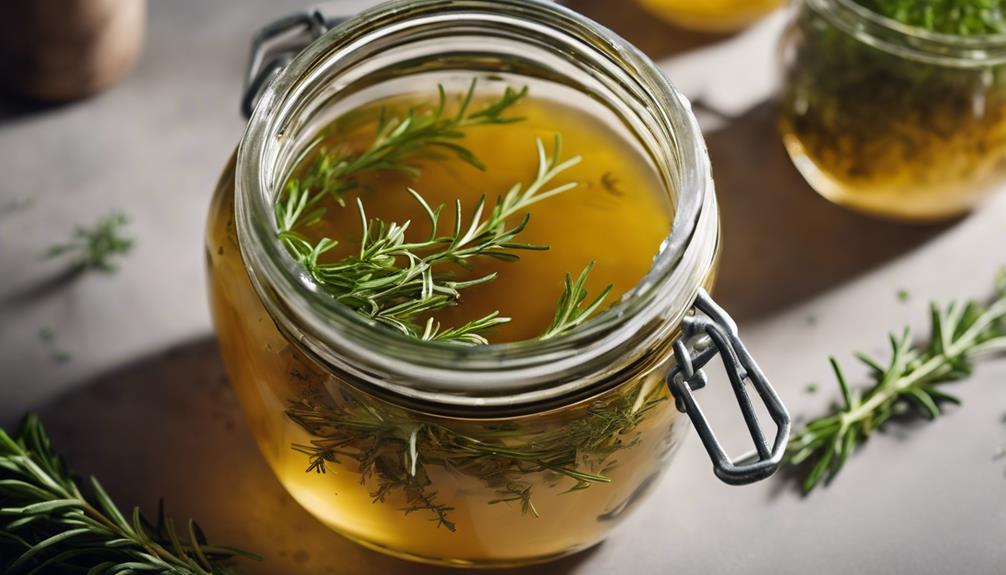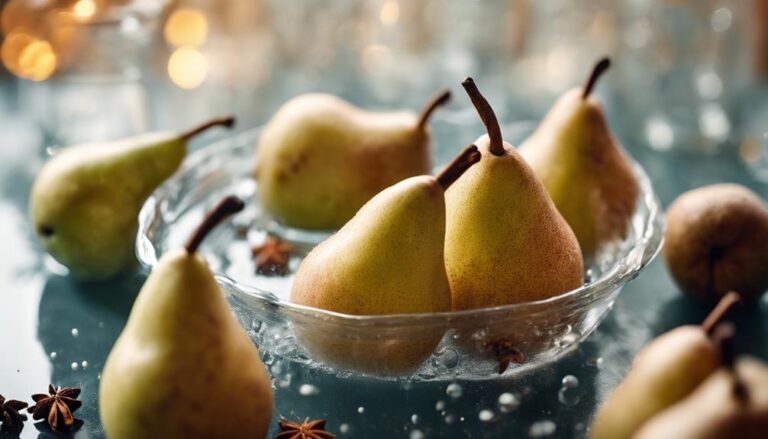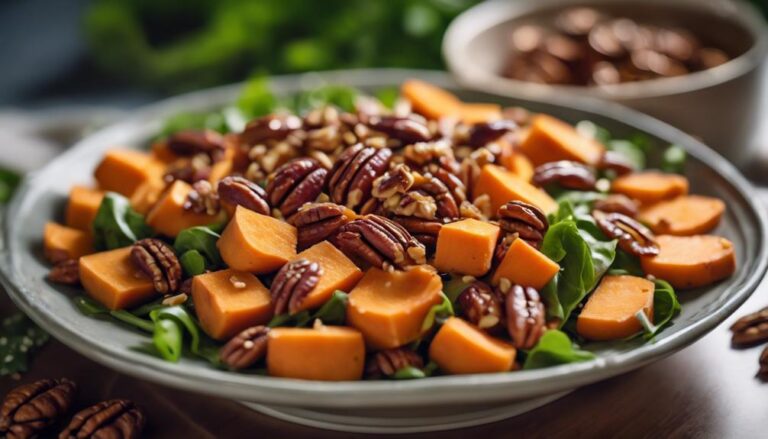Sous Vide Vegetable Broth With Fresh Herbs
Imagine this: veggies bathing in a warm water bath, mingling with aromatic herbs to create a symphony of flavors. The magic of sous vide locks in those tastes, making your broth burst with goodness. Season it just right, let those herbs work their charm, and voilà – a broth fit for a culinary maestro! Psst…wanna know more about how to take your broth game to the next level? Keep exploring the world of sous vide vegetable broth with fresh herbs for a tasteful journey!
What You Will Learn Here
- Use fresh herbs like rosemary, thyme, and parsley for aromatic infusion.
- Sous vide method enhances herb flavors and nutrients in vegetable broth.
- Vacuum-sealing ingredients ensures optimal herb extraction and flavor infusion.
- Precise temperature control in sous vide cooking for a rich herb-infused broth.
- Herbs add complexity and depth to vegetable broth, enhancing overall flavor profile.
Broth's Ancient Origins
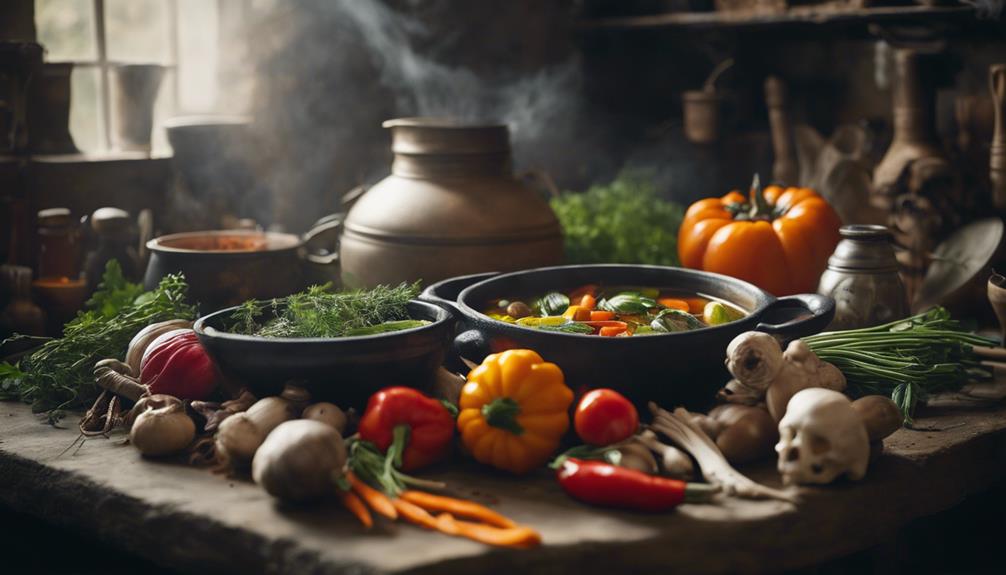
Imagine this: back in the days of yore, broth was more than just a tasty liquid – it was a way of life!
You see, people have been simmering veggies and herbs in water since forever, creating this magical elixir we call broth.
From ancient civilizations to modern kitchens, the art of broth-making has come a long way, evolving with time and cultural influences.
Broth's Historical Roots
Imagine this: ancient folks brewing up broths in their cauldrons, not just for flavor but also for its magical healing properties. These early broths weren't just soups; they were a lifeline, a warm hug in a bowl.
Consider the broth rituals, the historical context surrounding these bubbling pots of goodness. Broth wasn't just about taste; it was about survival, community, and care. Back then, broths weren't just for slurping; they were a whole cultural thing!
Medicinal uses, cultural practices, and a whole lot of love went into making these ancient broths. The roots run deep, my friend!
Evolution of Broth-making
Through centuries of culinary exploration and experimentation, ancient civilizations refined the art of crafting nourishing broths as a cornerstone of their diets and cultural practices.
The evolution of broth-making has seen a fascinating journey from simple boiling methods to the sophisticated modern techniques we use today. Imagine our ancient soup-loving ancestors stirring cauldrons over crackling fires, slowly coaxing flavor from bones and vegetables.
As time passed, techniques improved, resulting in clearer broths, richer flavors, and more efficient extraction of nutrients. Today, we've the luxury of sous vide methods and precise temperature control, elevating broth-making to a whole new level of perfection.
Cultural Significance of Broth
As you explore the cultural significance of broth, you uncover its ancient origins as a foundational element in diverse culinary traditions. Broth has been simmering its way through cultural traditions for centuries, adding depth and flavor to dishes worldwide.
From the hearty stocks of European kitchens to the delicate broths of Asian cuisine, it's clear that broth holds a special place in the hearts (and stomachs) of many. Not only does it bring a warm hug to your taste buds, but broth also boasts a treasure trove of health benefits.
Packed with nutrients and easy on the digestion, this liquid gold has been soothing souls and bodies since time immemorial. So next time you savor a bowl of broth, remember you're not just drinking soup – you're tasting history and wellness in a single sip.
Key Broth Components
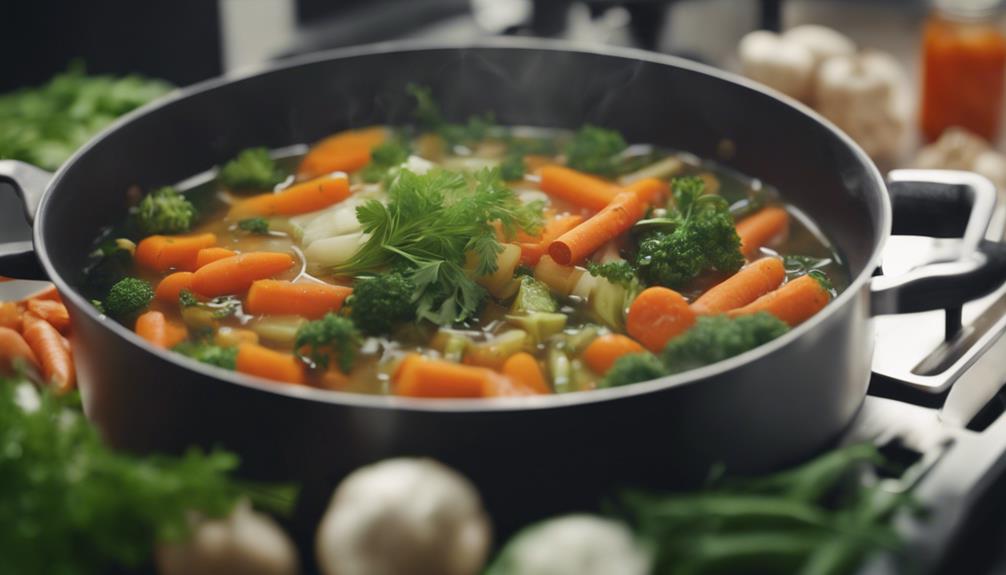
Enhancing the flavor profile of your vegetable broth can be achieved by thoughtfully selecting key components. Here are four essential elements to contemplate when crafting a delicious broth for your culinary creations:
- Nutrient Extraction: Make sure you include a variety of vegetables rich in vitamins and minerals to extract maximum flavor and health benefits. Carrots, onions, and celery are classic choices for a nutrient-packed broth base.
- Flavor Enhancement: Elevate the taste of your broth by adding aromatics like garlic, peppercorns, and bay leaves. These ingredients work together to create a harmonious blend of flavors that will make your broth truly irresistible.
- Broth Complexity: To enhance the depth of your broth, consider incorporating umami-rich ingredients such as dried mushrooms or seaweed. These savory additions will add layers of complexity to your broth that will leave your taste buds wanting more.
- Seasoning Balance: Strike the perfect balance of flavors by thoughtfully seasoning your broth with salt and pepper. Remember, you can always adjust the seasoning towards the end of the cooking process to ensure a perfectly seasoned broth that will be the star of your dishes.
Herb-Infused Broth Varieties
So, you're ready to take your vegetable broth game to the next level with some herby goodness!
Imagine the flavorful punch of a Herbed Vegetable Broth Recipe or the aromatic bliss of a Vegetable Consommé With Rosemary.
Get ready to elevate your broth-making skills with an Herbal Infusion for Broth that will have your taste buds doing a happy dance!
Herbed Vegetable Broth Recipe
Infuse your vegetable broth with a medley of fragrant herbs to elevate its flavor profile and create a versatile base for a variety of dishes. Here's how to take your broth to the next level:
- Seasonal Vegetables: Use a mix of seasonal veggies like carrots, onions, and celery for a robust flavor foundation.
- Aromatic Herbs: Add fresh herbs like thyme, rosemary, and parsley to bring a burst of aromatic goodness to your broth.
- Gentle Simmering: Slow cook your broth to allow the flavors to meld together and develop a rich depth.
- Taste and Adjust: Don't forget to taste your broth as it simmers and adjust the seasoning to suit your palate.
Vegetable Consommé With Rosemary
Consider incorporating the earthy aroma of rosemary into your vegetable consommé for a delightful herb-infused flavor profile. Here are a few tips to elevate your vegetable consommé with a rosemary infusion:
- Fresh Herbs: Use fresh rosemary sprigs for the best flavor infusion.
- Infusion Time: Let the rosemary simmer in the vegetable consommé for at least 20 minutes to fully impart its aromatic essence.
- Strain Well: After infusing, remember to strain the consommé to remove any rosemary leaves for a smooth texture.
- Adjust to Taste: Taste the consommé as you go; add more rosemary if you desire a stronger herbal kick.
Enhance your vegetable consommé with a touch of rosemary for a truly fragrant and flavorful experience!
Herbal Infusion for Broth
For a flavorful twist, enhance your vegetable broth by infusing it with a medley of herbs, elevating its taste profile to new heights. Here are some herb-infused broth varieties to tantalize your taste buds:
- Rosemary and Thyme Delight: Infuse your broth with these aromatic herbs for a comforting and earthy flavor.
- Lemon Verbena Infusion: Add a zesty and invigorating kick to your broth with this citrusy herb.
- Parsley and Sage Fusion: Create a balanced and savory broth by combining these classic herbs.
- Minty Fresh Broth: For a light and rejuvenating broth, try infusing it with fresh mint leaves.
Explore the herbal benefits and infusion techniques to create a broth that not only nourishes but also delights your senses.
Broth Enhancing Techniques
So, you want to take your veggie broth game up a notch? Let's talk about some cool ways to amp up that flavor!
From infusing your broth with intense flavors to nailing the perfect herb combinations, we've got you sorted for that broth that's *chef's kiss*.
And hey, we'll even spill the beans on how to get that broth crystal clear for that next-level presentation!
Flavorful Infusion Methods
To enhance the flavor of your vegetable broth, consider incorporating various infusion techniques and flavor combinations that will take your broth from bland to grand!
Infusion techniques involve adding ingredients like garlic, ginger, or peppercorns to simmer in the broth, imparting their delicious essence.
Experiment with different flavor combinations such as thyme and bay leaves for a classic touch, or lemongrass and kaffir lime leaves for an exotic twist.
These infusion methods work like magic, infusing your broth with layers of flavor that will have your guests asking for seconds.
Herb Pairing Suggestions
Enhance the depth of your vegetable broth by exploring herb pairing suggestions that elevate its flavor profile to new heights. When it comes to herb garnish, think about the different flavor profiles each herb brings to the table. Pairing herbs strategically can create a symphony of taste combinations that will make your broth truly outstanding. Check out the table below for some seasoning options and taste combinations that can take your vegetable broth from good to gourmet!
| Herb | Flavor Profile | Best Pairings |
|---|---|---|
| Rosemary | Earthy, piney | Potatoes, carrots |
| Thyme | Lemon, mint | Mushrooms, onions |
| Parsley | Fresh, peppery | Tomatoes, celery |
| Sage | Savory, slightly sweet | Squash, beans |
| Cilantro | Citrusy, pungent | Peppers, corn |
Broth Clarity Tips
For clearer and more visually appealing broth, consider these techniques to enhance its clarity.
To improve broth clarity, start by using clearing techniques like skimming off impurities that rise to the surface during cooking. Selecting ingredients wisely and avoiding starchy vegetables can also help achieve a crystal-clear broth.
Cooking time plays a pivotal role too; simmering the broth gently without vigorous boiling prevents cloudiness. To enhance flavor extraction while maintaining clarity, try not to stir the broth too much once it's simmering.
Final Thoughts
Consider reflecting on your experience with this sous vide vegetable broth recipe to fully appreciate the flavors and benefits it offers. The culinary benefits of this broth go beyond just taste. Think of the nutrients and wholesome goodness you're infusing into every dish you create using this flavorful broth. Your sustainability practices get a gold star for using up those veggie scraps that might've otherwise ended up in the compost bin.
As you sip on a warm cup of this vegetable broth, take a moment to pat yourself on the back for being a kitchen hero. Not only are you nourishing yourself and your loved ones with a delicious and healthy elixir, but you're also reducing food waste and contributing to a more sustainable way of cooking.
Frequently Asked Questions
Can Vegetable Broth Be Frozen for Later Use?
Yes, you can freeze vegetable broth for later use. Freezing benefits include extended storage time. Proper storage involves transferring the cooled broth into airtight containers or freezer bags, leaving room for expansion. Label with date for organization.
Is It Necessary to Peel Vegetables for the Broth?
When making vegetable broth, the peeling debate is ongoing. Leaving skins on enhances flavor but may affect clarity. Experiment to find what suits your taste. Skins hold nutrients, but peeling can create a cleaner broth.
How Long Can Herb-Infused Broth Be Stored?
When storing herb-infused broth, guarantee freshness by refrigerating it promptly. Extend its longevity by freezing portions in airtight containers or ice cube trays for easy access. Label and date containers for best preservation.
Can Different Cooking Methods Affect Broth Flavor?
When making broth, consider how different cooking methods like roasting vs. boiling or grilling vs. steaming can impact flavor. Roasting can deepen flavors, boiling can extract more, grilling adds smokiness, and steaming preserves freshness.
Are There Specific Herbs to Avoid in Broth Making?
When making broth, remember to choose herbs wisely. Certain combinations can have harmful effects. Be cautious with strong herbs like rosemary or sage. Opt for milder choices such as parsley or thyme to enhance your broth's flavor.
Conclusion
So there you have it, folks! With a little time, some fresh herbs, and a trusty sous vide machine, you can whip up a delicious vegetable broth that will take your soups, stews, and risottos to the next level.
Don't be afraid to experiment with different herb combinations and techniques to find your perfect flavor profile.
Happy cooking, and may your broth always be rich and flavorful!
